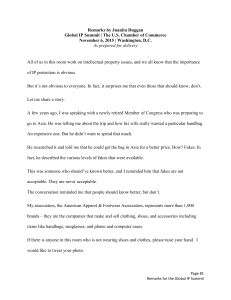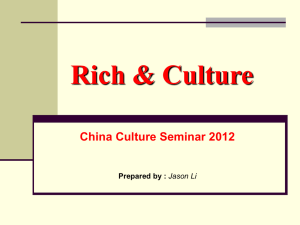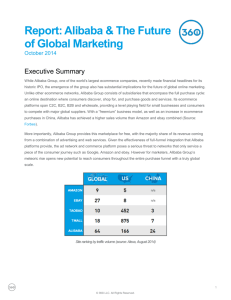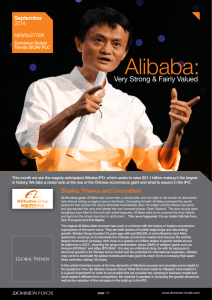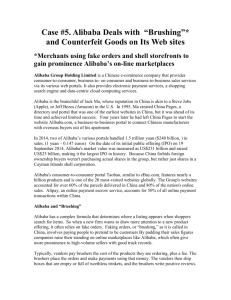Part 1 Unit 4 Section 2 MARKETING MIX AND TARGET MARKETS
advertisement
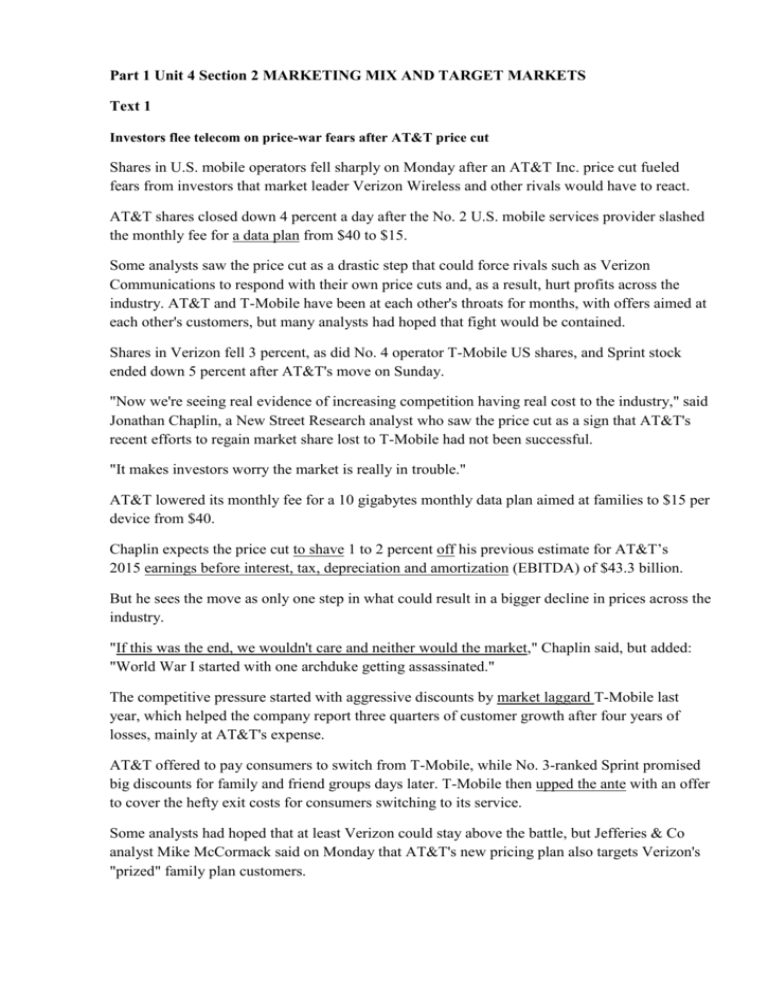
Part 1 Unit 4 Section 2 MARKETING MIX AND TARGET MARKETS Text 1 Investors flee telecom on price-war fears after AT&T price cut Shares in U.S. mobile operators fell sharply on Monday after an AT&T Inc. price cut fueled fears from investors that market leader Verizon Wireless and other rivals would have to react. AT&T shares closed down 4 percent a day after the No. 2 U.S. mobile services provider slashed the monthly fee for a data plan from $40 to $15. Some analysts saw the price cut as a drastic step that could force rivals such as Verizon Communications to respond with their own price cuts and, as a result, hurt profits across the industry. AT&T and T-Mobile have been at each other's throats for months, with offers aimed at each other's customers, but many analysts had hoped that fight would be contained. Shares in Verizon fell 3 percent, as did No. 4 operator T-Mobile US shares, and Sprint stock ended down 5 percent after AT&T's move on Sunday. "Now we're seeing real evidence of increasing competition having real cost to the industry," said Jonathan Chaplin, a New Street Research analyst who saw the price cut as a sign that AT&T's recent efforts to regain market share lost to T-Mobile had not been successful. "It makes investors worry the market is really in trouble." AT&T lowered its monthly fee for a 10 gigabytes monthly data plan aimed at families to $15 per device from $40. Chaplin expects the price cut to shave 1 to 2 percent off his previous estimate for AT&T’s 2015 earnings before interest, tax, depreciation and amortization (EBITDA) of $43.3 billion. But he sees the move as only one step in what could result in a bigger decline in prices across the industry. "If this was the end, we wouldn't care and neither would the market," Chaplin said, but added: "World War I started with one archduke getting assassinated." The competitive pressure started with aggressive discounts by market laggard T-Mobile last year, which helped the company report three quarters of customer growth after four years of losses, mainly at AT&T's expense. AT&T offered to pay consumers to switch from T-Mobile, while No. 3-ranked Sprint promised big discounts for family and friend groups days later. T-Mobile then upped the ante with an offer to cover the hefty exit costs for consumers switching to its service. Some analysts had hoped that at least Verizon could stay above the battle, but Jefferies & Co analyst Mike McCormack said on Monday that AT&T's new pricing plan also targets Verizon's "prized" family plan customers. McCormack said it was unlikely that Verizon would respond with service price discounts. But others were less convinced, as Verizon Chief Financial Officer Fran Shammo said this month that his company would react to competition when required. AT&T said its price change means that a family of four would pay $160 per month or $100 less than Verizon Wireless, or $80 less than Sprint Corp, and $20 less than T-Mobile US for a comparable service. Jackdaw Research analyst Jan Dawson said AT&T could increase its revenue by using price cuts to encourage more data usage. "The strategy is important as the market becomes saturated and there are fewer new customers to go around," he said. Reuters/2014 Vocabulary: 1. data plan – тарифный план 2. to shave smth. off smth. = to reduce 3. earnings before interest, tax, depreciation and amortization (EBITDA) = прибыль до вычета начисленных процентов по кредитам, налогов и амортизационных отчислений 4. market laggard ≠ market leader 5. to up an ante = to increase your demands or try to get more things from a situation, even though this involves more risks Translation Notes: 1. "If this was the end, we wouldn't care and neither would the market…" – см. Часть 3, стр. 426 «Сослагательное наклонение» Part 1 Unit 4 Section 2 MARKETING MIX AND TARGET MARKETS Text 2 Samsung's woes The rapid declines of Nokia and BlackBerry show how quickly fortunes can reverse in the mobile-device market. Is Samsung, now the world’s largest maker of smartphones, next in line? That question imposed itself after Samsung Electronics said on October 7th that its operating profit in the third quarter will be less than half the level it was a year earlier, down from 10.2 trillion won ($9.2 billion) to around just 4 trillion won. The profit warning was not entirely unexpected. As we pointed a few weeks ago, Samsung will need to change itself fast over the next few years in order to survive. Although smartphones have been the firm’s money maker in recent years, its global market share has dropped from nearly a third to 25% since January. And if Samsung had not lowered its prices and spent more on marketing, the collapse in sales would have been even greater. The firm's smartphone sales are being crushed from multiple directions. From below, low-cost makers from China, such as Xiaomi, and new European brands, such as Wiko, are attacking Samsung’s market, attracting away price-conscious customers. And from above, Apple is set to lure back wealthier shoppers with its new iPhone models. Moreover, as the smartphone market starts to reach its saturation point, the industry's growth as a whole is slowing. But Samsung’s biggest problem is that rival mobile devices are increasingly being sold alongside software and services that it cannot match. As Samsung is structurally a hardware company, it would surprise many if it suddenly came up with great apps or extra services. The firm’s best chance may be to stick with gadgets, and to try to create ones that consumers love so much that they fly off the shelves. Samsung seems to have a different plan, however. It is betting that its chip business, which has done well in the third quarter, will provide more of its growth. On October 6th the firm announced that it will spend nearly $15 billion on a new semiconductor plant in South Korea to meet the growing demand for processors in mobile devices. Although the decline of its smartphone business will not be an existential threat to Samsung, it remains to be seen whether making chips will replace all the profits it has lost. The Economist/2014 Vocabulary: 1. low-cost = low-priced 2. to be set to do smth. = to be about to do smth. = to be on the brink/verge of doing smth. Translation Notes: 1. “And if Samsung had not lowered its prices and spent more on marketing, the collapse in sales would have been even greater.” – см. Часть 3, стр. 426 «Сослагательное наклонение» 2. “…it would surprise many if it suddenly came up with great apps or extra services.” – см. Часть 3, стр. 426 «Сослагательное наклонение» Part 1 Unit 4 Section 3 PRODUCTS, SERVICES AND BRANDS; UPMARKET AND DOWNMARKET Text 3 Building brands in China Chinese shoppers love brands but don't purchase them consistently The streets of China's cities are alight with neon touting brand names from all over the world. Consumers eagerly trawl them, picking up Nike shoes, Samsung mobile phones and many other top-label products. A survey by McKinsey, a consultancy, shows that the Chinese consumer is enamored of brands. In categories such as consumer electronics, food and beverages, more than 80 percent of the respondents said that they buy name brands at least occasionally. For marketers, the problem is that despite this infatuation with brands, Chinese consumers don't consistently buy the same ones or even those they prefer. Price differences and point-of-sale marketing vehicles (e.g. in-store promotion or a salesperson’s suggestion) can change a consumer's behavior in a heartbeat. Asked to choose among three leading television brands - two foreign and one domestic - 49 percent of the survey respondents said they would pick Sony if prices were similar. But as the survey shows, a Sony premium of just 10 percent over the price of a TV from Changhong (a leading domestic brand) could make about a third of the people who say they prefer Sony choose its Chinese rival instead. Such attitudes result in a roller-coaster ride: market share in China can rise abruptly and then plummet. In 2002, for example, Motorola and Nokia commanded about 40 percent of the Chinese market for mobile-phone handsets. By 2003, despite a very strong reputation among consumers, their combined share had dropped to less than 30 percent as buyers switched to cheaper domestic brands. Brand loyalty, it seems, is not only generally low but also varies considerably from one product category to the next. Loyalty scores in China, for example, are about 50 percent higher for consumer electronics than for fast-moving consumer goods such as soft drinks and personal-care items. US consumers, by contrast, are much more loyal to sodas and other everyday purchases than to consumer electronics. Given the flexible attitude of many Chinese consumers, how should marketers build their brands? McKinsey experts revealed the potential of point-of-sale marketing techniques. They also found that many consumers respond to appeals that highlight performance features for some products and to nationalistic appeals (brand name, packing, getting endorsements from Chinese sports heroes, ect.) for others. Knowing which button to push, and when, could encourage greater brand loyalty. Mckinsey Quarterly Vocabulary: 1. name brand – известная торговая марка 2. marketing vehicle = marketing technique = marketing ploy – маркетинговый ход, маркетинговый инструмент 3. premium – наценка, надбавка к цене Translation Notes: 1. “Asked to choose among three leading television brands…respondents said…” – см. Часть 3, стр. 413 «Причастие в различных функциях» 2. “Given the flexible attitude of many Chinese consumers…” – см. Часть 3, стр. 416 «Причастие в функции союзов и предлогов» Part 1 Unit 4 Section 3 PRODUCTS, SERVICES AND BRANDS; UPMARKET AND DOWNMARKET Text 4 Chinese luxury labels to challenge Western counterparts Chinese consumers' love of Western luxury brands is well-documented and shows no sign of flagging. But there is a small but growing stable of companies who are betting that Chinese luxury goods buyers will begin to seek out items that reflect their own culture, rather than just the European heritage and exclusivity that have been so popular to date. Experts say it will be an uphill struggle for such brands to take on the prestige and marketing power of well-established luxury goods and fashion houses. Henry Steiner, who runs Hong Kong-based Steiner & Co that advises companies about brand creation and strategy, is sceptical about the chances of a high-end Chinese brand emerging any time soon. "They have to go through this very difficult process of not just coming up with a cute idea, but really building a company and sticking their neck out when it comes to marketing," he says. "Western brands come with a certain personality that's been built up over the years, with recognition and consistency - all the things that Chinese brands don't have." Few Chinese brands have recognition in the West - luxury or otherwise. According to a survey of 1,476 people conducted in France, Germany and the UK, only a few could recall any Chinese brands. Some 7% named PC maker Lenovo, while 2% named mobile phone handset maker Huawei and appliance maker Haier. Saurabh Sharma from Ogilvy & Mather, an advertising agency in Beijing, says that Chinese companies do have a genuine opportunity to thrive in the luxury sector. "If they do things in a more personal way instead of a packaged format, they will get a bigger margin out of it,” he says. "Given the strength of Western brands, the challenge for Chinese companies is to revive the timeless aesthetic that China had before in Ming furniture, Song porcelain and Han-dynasty dress,” he adds. BBC/2014 Vocabulary: 1. packaged format – товары массового (серийного) производства Translation Notes: 1. “…the chances of a high-end Chinese brand emerging any time soon.” – см. Часть 3, стр. 411 «Герундиальный комплекс» 2. "Given the strength of Western brands…” - см. Часть 3, стр. 416 «Причастие в функции союзов и предлогов» Part 1 Unit 4 Section 4 ADVERTISING AND PROMOTION Text 5 Making the social sale Brands like Amex and Coca Cola show how to win the peer to peer recommendations that are the holy grail of marketing Every year, millions of pounds are ploughed into product advertising to get people into shops. Millions again are spent on shopper marketing to close the deal in store. So, when a customer walks into a shop and buys a product, a marketer would be justified in thinking "Job done! My marketing has worked". However, this old world of consumerism has now changed. Now there is another element in the purchase equation to consider: social media. Before, a customer would buy your product, perhaps tell a friend or two if they were particularly impressed or disappointed, and then they were forgotten until they walked back into your store. Not exactly a social process. The proliferation of social media means that this kind of sale is now a wasted opportunity - or a "dead sale". Now, after a customer buys a product, the next stage of the shopper process should be the “social sale”. A social sale is when a customer who has purchased a product shares the purchase with their social communities, raising awareness of the product (and the place it's been purchased from). It is giving a peer-to-peer recommendation, the holy grail of marketing. It is not difficult to understand why the principle of a social sale makes sense. People are curious by nature. They want to know where their friends are eating and drinking, where they go on holiday, or whether they are making a big purchase like a car or house. Add this to the ever-growing use of smartphones, with people checking into venues and locations in their millions every day, worldwide. A social sale brings these behaviours together, in a way that benefits a brand. Some brands are already harnessing this behaviour. For example, Amex teamed up with department store Harvey Nichols to reward fans money off their shop if they purchased items over £25 then checked-in on Foursquare, and it then expanded the campaign to Twitter, offering its customers a whole host of discounts if they used specific hashtags for brands like McDonalds, Whole Foods and Dell. Our own research recently found that thousands of people each month are snapping and sharing product photos from supermarkets on Instagram, with brands like Coca Cola featuring regularly due to their personalised bottle campaign. This was an evolution even on the previous example - Coke didn't even need an incentive, by creating a clever product that put the consumer at the centre of the marketing process, the social sales were generated organically. While campaigns like these are leading the market, the social sale is not happening regularly yet. It is still in its infancy, but it has the potential to revolutionise the purchase process in years to come. Mobile, shopper and social media marketing are no longer separate disciplines. They need to evolve, and be considered as a cohesive whole, to allow each element to play to its true strength. The Guardian/2013 Vocabulary: 1. Термин “social sale” связан с понятием “social media marketing”=promoting goods and services via social media: social networking sites, blogs and other user-generated venues =маркетинг в социальных медиа=маркетинговая техника, использующая социальные сети, блоги, форумы и т.д. для повышения осведомлённости о бренде/товаре/услуге. Основной упор при этом делается на создании контента, который люди будут распространять через социальные сети самостоятельно, уже без участия организатора (viral marketing=вирусный маркетинг). В результате, маркетинговое сообщение, подобно вирусу, передается от одного лица другим лицам (этот акт обмена информацией о товаре между пользователями и определяется автором статьи как “social sale”). Главными преимуществами социального маркетинга является то, что активным рекламоносителем является сам пользователь, “заражающий” идеей распространения данного продукта других, а также тот факт, что оригинальные ролики, тексты и т.д. передаются в виде рекомендуемых ссылок, в результате чего, информация о товаре ассоциируется скорее с досугом, нежели с навязанным рекламным обращением. Кроме того, продвижение в социальных сетях позволяет точечно воздействовать на целевую аудиторию, выбирать площадки, где эта аудитория в большей степени представлена, при этом в наименьшей степени затрагивая незаинтересованных в этой рекламе людей. Термин “social marketing” означает социальный маркетинг как комплекс маркетинговых мероприятий, направленных на популяризацию социально-значимых идей (например, вреда курения, необходимости заниматься спортом и т.д.) и не преследующих коммерческие цели . 2. Amex = American Express = Финансовая компания, известными продуктами которой являются кредитные карты и дорожные чеки. Штаб-квартира компании находится в Нью-Йорке. 3. peer-to-peer (recommendations) = прямой обмен информацией между интернет-пользователями (подписчиками социальных сетей, участниками форумов и блогов и т.д.); синоним = word of mouth; 4. shopper marketing = шоппер-маркетинг = марткетинговые мероприятия в месте покупки, т.е. в магазине; его цель - побудить посетителя магазина принять решение о покупке на месте, вблизи от товара, таким образом, превратив его в покупателя. 5. consumerism = консюмеризм = уклад общества, потакающий покупке товаров и услуг, часто в больших количествах и сверх всякой необходимости. Помимо этого значения, под консюмеризмом может пониматься движение потребителей за расширение и защиту своих прав (например, от недобросовестной рекламы, вздутых цен, низкого качества). В данном контексте этот термин можно перевести как «модель потребления» или «модель взаимодействия между покупателем и маркетологом». 6. to close a deal = to clinch a deal = to complete a deal successfully 7. social media = социальные медиа = социальные средства коммуникации = средства коммуникации с использованием основанных на интернет - технологиях каналов и площадок для общения и обмена контентом между пользователями, таких как форумы, блоги, социальные сети, фото- и видео-хостинги, платформы для совместного творчества. 8. Harvey Nichols = элитный универмаг в районе Найтсбридж в Лондоне 9. hashtag = хештэг = тематическая метка в социальных сетях 10. personalized = customized = tailored Coca-Cola’s personalised bottle campaign=рекламная кампания “Share a Coke”=одна из наиболее примечательных интернет-кампаний Coca-Cola. Суть кaмпании заключается в возможности заказать персональную брендовую бутылку, используя приложение на Facebook, а затем отправиться за уникальной газировкой в магазин. 11. mobile marketing = мобильный маркетинг = комплекс маркетинговых мероприятий, направленных на продвижение товаров или услуг с использованием средств сотовой связи. Translation Notes: 1. “Now there is another element in the purchase equation to consider: social media.” – см. Часть 3, стр. 407 «Инфинитив в различных функциях» Questions for Discussion: 1. How does the author identify the “Holy Grail of Marketing”? 2. Define the phenomenon of social media marketing. How different is it from traditional marketing ploys? What marketing activities can be classified under shopper marketing? 3. What factors (both economic and non-economic) contributed to the emergence and proliferation of social media marketing? 4. In what way can companies take advantage of social media marketing? Provide the most successful business stories. 5. Dwell on the potential prospects for social media marketing. Part 1 Unit 5 Section 1 RAISING FINANCE Text 6 Alibaba’s IPO From bazaar to bonanza China’s e-commerce giant has just revealed details of its long-awaited flotation in America. It will be a blockbuster. Alibaba’s triumph has been breathtaking. The firm’s portals control four-fifths of all e-commerce in China. Taobao, a portal that consumers use to sell to each other, is the country’s leading ecommerce website, and Tmall leads the business-to-consumer (B2C) market. Measured by the value of goods sold on its platforms, Alibaba is bigger than eBay and Amazon combined. But Mr Ma, who founded Alibaba in his apartment back in 1999, may soon best Silicon Valley rivals in another way: Alibaba could become the largest-ever initial public offering (IPO) in America. After many months of speculation, on May 6th Alibaba unveiled its prospectus to list in New York. Pundits have been breathlessly predicting that this flotation could raise $15 billion-20 billion, making it one of the biggest ever. Polls of analysts suggest that the resultant valuation of the firm could exceed $150 billion. In its filing, Alibaba revealed its valuation of itself, based on what it thinks existing shares are worth: roughly $110 billion. But boosters arguing for much higher valuations are sure to pick up on other figures included in the filing. For example, punters spent nearly $250 billion on the firm’s e-commerce sites last year. Alibaba’s revenues surged by over half and its profit margin exceeded 40% during the last nine months of 2013. Still, the short-term outlook is dicey. The value of technology stocks listed in America has fallen by perhaps $150 billion since a peak in early March. Chinese stocks are out of favour, too. It explains why Alibaba has decided to offer merely a token amount at first—the prospectus says $1 billion—to test the waters. This will be raised in coming months as demand allows. The firm’s bosses remember all too well that the over-hyped IPO of Facebook two years ago initially flopped. But Facebook later rebounded: its shares are up by half since flotation and its market value stands at roughly $150 billion. That example suggests that the right way to judge Alibaba’s future is to look beyond the inevitable ructions of the coming weeks to its longer-term prospects. As is typical of IPO filings, Alibaba’s prospectus outlines lots of risks. Regulatory uncertainty is one worry. For example, Chinese officials could interfere with AliPay, an online-payments system started by the firm that is vital to its success not only in e-commerce but also in internet finance and other areas of expansion. AliPay is currently not part of the group being floated in New York. It is held by a sister financial firm controlled by Mr Ma and a handful of associates, having been spun out of Alibaba in 2010. Mr Ma now plans to reduce his holding in AliPay from 46% to roughly 8%. This would allow the listed firm to reclaim a big stake in AliPay—if regulators permit a foreign entity (which Alibaba’s Cayman-registered vehicle would be) to invest in the payment system, something they have not been keen on in the past. The Cayman Islands vehicle poses another risk: the prospectus warns that “your ability to protect your rights through the US Federal courts may be limited”. Yet another worry for ordinary shareholders (one that led the Hong Kong stock exchange to reject Alibaba’s IPO) is that a handful of insiders led by Mr Ma will have the power to control the board without owning a majority of the shares. These sorts of risk look manageable. The bigger worry is that the age of easy profits is over. Alibaba’s dominance of Chinese e-commerce is an artefact of the era of the personal computer (PC). But faster than in any other big market, China is moving to mobile commerce. It is already the world’s largest market for smartphones. The firm says “an increasing percentage of our users are accessing our marketplaces through mobile devices, a trend that we expect to continue.” The path ahead for Alibaba will not be easy, but the competition to come should make the firm fitter. If it answers the challenges with agility and innovation it will do more than merely defend its turf as China’s e-commerce king. Alibaba will then deserve to be one of the most valuable companies in the world. The Economist/2014 Vocabulary: 1. bonanza – высокодоходное предприятие, источник наживы, «золотое дно» 2. Taobao – портал электронной коммерции для физических лиц, т.е. по схеме «потребитель для потребителя» (consumer-to-consumer); Tmall – портал электронной коммерции по схеме «предприятие – конечный потребитель» (business-to-consumer) 3. to best = to defeat 4. Silicon Valley – Кремниевая долина 5. prospectus – проспект эмиссии 6. pundit – эксперт, ученый муж (ироничное название для бизнес-аналитиков) 7. filing (IPO) – подача заявки на осуществление первичного публичного размещения акций 8. punter – здесь – покупатель 9. Alibaba’s Cayman-registered vehicle would be = компания Alibaba Group Holding Ltd. зарегистрирована на Каймановых о-вах 10. insider – инсайдер = член организации, компании 11. one’s turf – an area that you think of as being your own Part 1 Unit 5 Section 2 MARKET PLAYERS. TRADING ON MARKETS Text 7 Hopes rise for success of ECB’s stimulus plan In March 2009, the US Federal Reserve and the Bank of England announced plans for quantitative easing. A six-year equity bull run followed as a combination of QE, fiscal reforms and US banking measures helped avert an implosion of the financial system and cleared the way for economic recovery in the US and UK. The question now on the lips of fund managers and market participants is: Will the European Central Bank’s version of QE act a similar catalyst for equity markets, in effect lifting all boats in a massive rescue operation to address the economic ills of the eurozone? So far, the signs are good. Since last Thursday’s announcement of a €1.1tn injection into the eurozone financial system, UK and European equity markets have risen — and a newfound confidence has spread across trading floors and asset management houses in Europe’s main financial centres. Stocks in a range of sectors and countries have been buoyed as hopes grow that the ECB’s move might turn out to be a key moment in restoring the eurozone to economic health. Carrefour, the French supermarket chain, Siemens, the German engineering group, and BP, the UK oil major, are just some examples of companies that have enjoyed a QE boost in the past week. Even victory for Syriza, Greece’s leftist party that wants extensive debt relief, in elections on Sunday failed to dent the optimistic mood among some asset managers and market participants as the ECB’s decision to implement a €60bn-per-month bond-buying programme until at least September 2016 offset worries over a potential default in Athens. Simon Evan-Cook, senior investment manager at Premier Asset Management, says: “This is a big moment for the ECB and European stocks. I’m not sure that it will have the same effect as the ECB’s promise to do everything in its power to save the euro back in 2012, but it is certainly a major boost.” John Stopford, co-head of multi assets at Investec Asset Management, agrees: “The bond-buying programme will mean people will use the money from selling their bonds to buy other assets such as equities, while increased confidence will act as a positive too.” He thinks cyclical and discretionary stocks, such as those in the retail sector, will probably benefit more than defensive and staple stocks, such as utilities and telecoms that are more immune to the vagaries of the economic cycle. He adds that the weakness of the euro, which slid against the dollar on the news that the ECB was starting up the electronic printing presses, will be one of the main drivers behind rising equity markets as it paves the way for an export-led recovery. Another driver will be a lower oil price, which should increase consumer demand for other goods and services. A weaker euro will benefit Europe’s exporters, such as German manufacturer Siemens, and retail groups such as Spain’s Inditex, which draws a large chunk of its revenues from overseas businesses. However, investors recognise QE is not a “magic solution”. For a start, one of the aims of QE is to encourage more private bank lending, which would heap more debt on an already highly indebted region. Although more lending could encourage economic growth, in the long run it may have a limited effect as indebted consumers are finally forced to keep a check on their budgets. The recovering US economy could also prove a problem for eurozone stocks. Although high valuations in the US have deterred investors, uncertainty surrounding Greece and political risks, with UK and Spanish general elections this year, could encourage some investors to switch cash across the Atlantic. Finally, at some point, Europe’s equity markets will have to cope in a world without QE. Big eurozone economies such as France and Italy must tackle structural problems in their public sectors and labour markets or exiting the programme may prove tricky, warn analysts. The Financial Times/2015 Vocabulary: 1. asset management house – компания по управлению активами 2. cyclical stocks – «циклические» акции = динамика курса акций копирует (следует за) деловым циклом; staple stocks – акции компаний, специализирующихся на производстве товаров и оказании услуг первой необходимости; staple stocks ≠ discretionary stocks; 3. vagary – превратность, выходка, причуда 4. export-led (recovery) = export-driven = export-oriented Translation Notes: 1. “…which should increase consumer demand for other goods and services.” – см. Часть 3, стр. 403 «Модальный глагол “should”» Part 1 Unit 5 Section 3 UNVEILING RESULTS Text 8 Stocks rally for 2nd day: Dow surges 305 points; oil jumps 7% The January blues on Wall Street have given way to green arrows and gains in February for a second straight session as Wall Street reacts to firming oil prices, less gloomy news related to Greece and another global central bank cutting interest rates. The Dow Jones industrial average surged 305.36 points, or 1.8%, to close at 17,666.40. The Standard & Poor's 500 index gained 29.18 points, or 1.4%, to 2050.03. The Nasdaq composite rose 51.05 points, or 1.1%, to 4727.74. Oil on the U.S. market surged as much as 7%, to close at $53.05 a barrel in New York. After a seven-month drop of more than 50%, speculation is rife that oil prices might have found a bottom as producers cancel projects and more drilling rigs stand idle. The market gains gains come on top of Monday's strong rally as the Dow jumped almost 200 points, putting its two-day total to 501 points. That's the best two-day gain for the blue-chip index since Jan. 7-8. February is so far proving to be a healthy antidote to a dismal start to 2015 in January. The weakness in the first month of the year had spooked Wall Street, as history says a down January often suggests a rocky road for stocks for the entire year. Car sales continue to hum, as well. Ford Motor sales jumped 15.3%, General Motors gained 18.3% and Chrysler Group sales were up 14% from a year earlier. Energy stocks boosted the market as Exxon-Mobil, which jumped 3%, and Chevron, up 3.3%, helped lead the Dow higher. The energy sector was the leading S&P 500 sector, rising 2.8%. Hopes for a deal between Greece and its European creditors got a boost after the country's new government backed away from demands to write off a chunk of its bailout loans, a prospect that had horrified creditors and investors. "Central bank easing, European political progress, and a temporary halt to the collapse in crude is all constructive for U.S. assets," Paul Hickey, co-founder of Bespoke Investment Group told clients in an early-morning research note. Stocks got a boost as two major headwinds - plunging oil prices and fears of a Greek exit from the eurozone - lessened amid upbeat news on both fronts. Greek stocks led a European market rally Tuesday. The Athens stock exchange rose as Greek bond yields eased, a sign investors are less worried about default. The Euro Stoxx index of eurozone stocks gained nearly 1%. Australia's central bank cut its benchmark interest rate for the first time since August 2013 to a record low of 2.25% Tuesday in a bid to jolt an economy weighed down by falling commodity prices. The news shook the Australian dollar which dropped 1.8 %. The stock market was boosted, with the S&P/ASX 200 up 1.4%. Oil giant BP reported a loss of $4.4 billion in the fourth quarter of 2014, as oil prices plunged. In Asia, Japan's Nikkei 225 index dropped 1.3% to close at 17,335.85 and Hong Kong's Hang Seng index rose 0.3% to 24,554.78. The Shanghai Composite gained 2.5% to 3204.91. www.usatoday.com/2015 Vocabulary: 1. rife – частый, распространенный, господствующий 2. bailout – оказание финансовой помощи проблемным компания/банкам/странам 3. headwind – препятствие, сдерживающий фактор 4. The Euro Stoxx index – фондовый индекс «голубых фишек» Еврозоны 5. S&P/ASX 200 – фондовый индекс 200 «голубых фишек» Австралии, котирующихся на Австралийской фондовой бирже (Australian Securities Exchange) и рассчитываемый компанией Standard and Poor’s 6. Japan's Nikkei 225 – основной фондовый индекс Японии, рассчитываемый как среднее арифметическое цен акций 225 компаний, котирующихся на Токийской фондовой бирже Part 1 Unit 5 Section 3 UNVEILING RESULTS Text 9 We're on the verge of a crisis, bears warn Wall Street's bears are back in vogue. After nearly six years of a surging U.S. stock market, investors are worried about how much longer it will last. Suddenly, the views of the negative Nancys are getting a lot of attention. The bears build their case that a crisis is near on four factors: falling oil prices, stagnant wages, the "two-edged sword" of a strong US dollar and big trouble abroad. "Earnings and economic activity are actually weakening, not strengthening," says James Abate, chief investment officer at Centre Asset Management, which manages over $8 billion. "The growth outlook, to us, is deteriorating." One of the biggest problems companies face right now is the strong U.S. dollar. The euro recently hit an 11-year low of about $1.10 to the euro. It may sound good - it's more affordable to travel to Europe - but it hurts U.S. companies selling their products abroad. Consider that Microsoft reported solid earnings Tuesday, but its shares dropped as much as 10% because it's forecasting weaker sales abroad due to the strong U.S. dollar. The same is true for Procter & Gamble and United Technologies, some of America's biggest companies, which employ thousands. "There are limits to how much further the U.S. dollar can appreciate before it starts to bite more seriously into economic activity," says Sheryl King, senior director of research at Roubini Global Economics and a former Bank of America economist. Similar to the dollar, there are two sides to the dramatic drop in oil prices from over $100 a barrel last summer to $45 now. Americans love cheap gas at the pump, but low oil prices are forcing corporations to scale back on jobs and spending. The oil sector has added over half a million jobs - many of them high paying - since the recession ended in June 2009. That's 13% of all US job growth over that period. Now energy companies and related sectors are laying off thousands. Expect that trend to continue, bears say. "The plunge in oil prices will continue and lead to more, I think, worry comments as these companies start to report each quarter," says Brian Sozzi, chief equity strategist at Belus Capital Advisors. It's already hurting corporate earnings. Take Tuesday, for example: the Dow fell 291 points after Caterpillar, the nation's largest building equipment company, reported a 25% decline in profits due to business slowdown in oil-producing regions. Beyond oil, the global economic picture makes bears believe that the U.S. cannot be the tug boat pulling everyone ahead. Growth in China is slowing. The European Central Bank is throwing a life raft to its nations drowning in deflation, and Japan is already deflating. On top of that, Greece just elected a leader almost certain to cause tension with other European leaders and tensions are flaring up again between Russia and the Ukraine. "Everyone seems to be falling or faltering in some way abroad,” says Matt Kerkhoff, research director at Dow Theory Letters, an online newsletter. The American economy, "cannot really outperform while all the rest are in shambles." The question is whether American consumers and businesses will spend enough to offset the global slowdown. But so far, wages have been flat for many Americans during the recovery. Adjusted for inflation, median weekly wages were $790 in the fourth quarter of 2007; they barely budged up 1% to $796 the last quarter of 2014. Weaving their four factors together, the bears' quilt for 2015 is quickly looking gloomy and gray. CNNMoney/2015 Vocabulary: 1. the negative Nancy – пессимист 2. median – среднее значение Part 1 Unit 6 Sections 2, 3 THE BALANCE SHEET. FINANCIAL STATEMENTS AND THE BOTTOM LINE Text 10 Regulators publish new global revenue accounting standard After more than a decade of effort, regulators yesterday published a global accounting standard that will overhaul the way businesses record revenue on their books, allowing investors to better compare how much companies from countries around the world earn. In a major step towards creating a converged set of international accounting rules, global standard setter the IASB and US counterpart FASB released a converged standard on the recognition of revenue from contracts with customers that will improve comparability of financial statements globally. The core principle of the new common global standard, which replaces the fragmented set of rules by which companies in different industries booked their revenues differently, is for companies to recognise revenues in a way that shows the transfer of good and services to customers that reflects the payment to which the company expects to be entitled. "The revenue recognition standard represents a milestone in our efforts to improve and converge one of the most important areas of financial reporting. It will eliminate a major source of inconsistency in GAAP, which currently consists of numerous disparate, industry-specific pieces of revenue recognition guidance," said Russell Golden, chairman of FASB. The new standard will also enhance disclosure about revenue and provide guidance for transactions that were not previously addressed comprehensively. In order to recognise revenue under the new rules, known as IFRS 15, companies will need to follow a five step process which begins by matching the contract with a customer, identifying the performance obligations in the contract, determining the transaction price, which is then allocated to performance obligations with revenue recognised as each performance obligation is met. According to members of the accountancy profession, the changes will be most keenly felt by companies that offer complex bundles of goods and services or provide long-term service contracts - such as telecoms, construction, real estate and software companies. "For some of these companies, the change may present a formidable challenge. This will involve assessing the impact of the standard on all the company's revenue streams and determining what customers pay for each element of goods and services sold as packages. This can be a complicated task," said Nigel Sleigh-Johnson, head of the reporting faculty at ICAEW. "For many other businesses - such as those undertaking straightforward retail transactions - the standard will mean only limited change." The new rules might also require changes to companies' systems and processes of collecting the necessary data, experts said. "It will have significant knock-on effects on the reporting of key performance indicators, for example, and may impact companies' internal systems. Companies should not underestimate the possible impact of the new standard either in terms of change in revenue profile and the potential need for changing systems, processes and disclosures," said Veronica Poole, Deloitte's global IFRS technical leader. Brian O'Donovan, partner with KPMG's International Standards Group based in London, praised the joint standard as "a major achievement for the standard setters" but added that, for companies, the "real work is just beginning". Companies using IFRS will need to apply the new standard for reporting periods beginning on or after 1 January 2017, though early adoption is allowed. Hans Hoogervorst, chairman of the IASB commented: "The successful conclusion of this project is a major achievement for both boards. Together, we have improved the revenue requirements of both IFRS and US GAAP, while managing to achieve a fully converged Standard. Our attention now turns to ensuring a successful transition to these new requirements." www.financialdirector.co.uk/2014 Vocabulary: 1. IASB = International Accounting Standards Board – Совет по международным стандартам бухгалтерского учета 2. FASB = Financial Accounting Standards Board – Совет по стандартам бухгалтерского учета 3. recognition of revenue – признание (учет) выручки (дохода); в рамках данных правил учета выручка признается в момент (или по мере) исполнения компанией обязательств по контракту (передача покупателю товаров или услуг) и отражает ту сумму, которую продавец рассчитывает получить в обмен на поставленные товары и услуги, а не в момент фактического получения денежных средств. 4. GAAP = Generally Accepted Accounting Procedures – Общепринятые правила бухгалтерского учета 5. IFRS = International Financial Reporting Standards – Международный стандарт финансовой отчетности 6. performance obligations – обязанности, подлежащие исполнению в рамках договора (передача товаров или услуг покупателю) 7. ICAEW = Institute of Chartered Accountants in England and Wales – Институт дипломированных бухгалтеров в Англии и Уэльсе 8. straightforward transactions – простые сделки 9. knock-on effect = ripple effect = chain reaction Part 1 Unit 6 Section 4 BANKRUPTCIES Text 11 Quiznos Follows Sbarro Into Bankruptcy Court Quiznos Corp., the Denver-based toasted-sandwich chain, filed for bankruptcy days after pizzeria company Sbarro LLC sought protection from creditors, as competition among fast-food restaurants grows in a tight market. Quiznos said it’s seeking to implement a reorganization that would cut debt by $400 million. Most of its senior lenders support the plan and the chain will keep operating during bankruptcy, according to a company statement yesterday. Competition among U.S. restaurants has been increasing as newer entrants expand quickly. Sbarro filed for bankruptcy on March 10, while the owner of Hot Dog on a Stick filed last month, as foot traffic in shopping malls dwindled and chains such as Panera Bread Co., Chipotle Mexican Grill Inc. and Subway Restaurants cut into their business. “It’s a survival of the fittest,” Bob Goldin, executive vice president at Chicago-based restaurant researcher Technomic Inc., said in an interview before yesterday’s filing. “The market is not growing, or it’s barely growing, so the weak players are getting weeded out.” Quiznos said it will seek court approval of a $15 million loan from its senior lenders to continue operations as it restructures. The company expects to execute its plan and emerge from bankruptcy on an “accelerated basis,” according to the statement. An initial hearing is scheduled for March 17 in U.S. Bankruptcy Court in Wilmington, Delaware, where the case was filed. In 2012, Quiznos underwent an out-of-court financial restructuring that eliminated about $300 million in debt and gave majority ownership to billionaire Marc Lasry’s Avenue Capital Group LLC through a $150 million equity infusion and debt-to-equity swap. Quiznos, founded in 1981, operates restaurants in all 50 states and 34 countries. It has about 2,100 stores, all but seven of them franchised, according to yesterday’s statement. The chain sells toasted sandwiches and recently added pasta dishes, such as chicken pesto and macaroni and cheese with bacon, to its menu. “They expanded too fast, they had a weak franchisee network,” Goldin said. “Once Panera bread came along, I think, many consumers thought that was a better quality price point. And Subway came in on the lower end and aggressively promoted themselves as fresh.” High unemployment affected Quiznos’s stores, which are found primarily in office plazas and “high-end” shopping malls, the company said in a filing. Quiznos Chief Executive Officer Stuart K. Mathis said in yesterday’s statement that the company plans to cut food costs, make loans available to some franchisees for improvements and invest in advertising, as well as add technology to boost efficiency. Bloomberg/2014 Vocabulary: 1. senior lenders – кредитор первой очереди, кредитор с преимущественным правом требования компенсации 2. out-of-court – во внесудебном порядке 3. debt-to-equity swap – конверсия долга в акции

